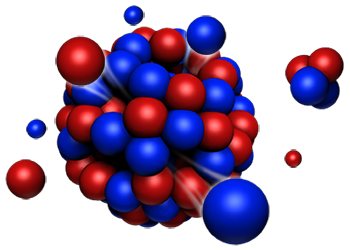Speaker
Description
The SPS Beam Dump Facility (BDF) Project [1], currently in its comprehensive design phase, is a proposed general-purpose fixed target facility at CERN, dedicated to the High Energy Physics (HEP) community and specifically to the Search for Hidden Particles (SHiP) experiment in its initial phase in the framework of the Physics Beyond Colliders (PBC) initiative [3].
At the core of the installation resides a high-Z target/dump assembly, whose aim is to fully absorb the high intensity proton beam slowly extracted from the Super Proton Synchrotron (SPS) at 400 GeV/c (355 kW average power). One of the most challenging aspects of the proposed installation resides in the high beam energy and the deposited power density reached during operation, up 18 MW/m3 and 2.6 MW per pulse, and in its pulsed nature. These conditions are quite similar to those encountered in a new generation neutron spallation sources.
The foreseen BDF target/dump is a water-cooled TaW-cladded segmented TZM (Mo-alloy) and pure W hybrid core [4]. The assembly is 250 mm in diameter and 1500 mm total length with single blocks from 25 to 350 mm long, optimized in terms of physics and their thermo-mechanical response. The cladding is ensured by diffusion bonding by means of the hot isostatic pressing (HIP) technique. The target/dump design features are quite similar to neutron targets such as ISIS (UK) and the future STS (US).
Significant R&D has been dedicated to the optimisation of the cladding process, with detailed studies on the diffusion bonding, thermal conductivity and optimisation of the hot isostatic pressing cycles, also aimed at validating new materials such as TZM and Ta2.5W [5].
In order to validate the design of the BDF target, a scaled prototype target/dump has been constructed and a beam test has been executed in October 2018 at CERN. The prototype has the same configuration as of the final target, with the exception of the diameter, 80 mm rather than 250 mm.
The BDF target complex has been also studied in detail, in order to optimize the handling process of the target and the shielding components as well as to take into account all relevant radiation protection recommendations [6]. An online innovative He passivation system has also been developed, with the objective of having an inert helium gas atmosphere around the production target and the shielding assembly to reduce activation and radiation assisted corrosion.
The contribution will summarize the main aspects of the facility, highlighting relevant aspects of this HEP facility for the worldwide spallation neutron community as well as the future prospects and R&D.
[1] https://doi.org/10.18429/JACoW-IPAC2017-TUPVA126
[2] https://doi.org/10.1088/1748-0221/14/03/P03025
[3] https://arxiv.org/pdf/1902.00260.pdf
[4] https://arxiv.org/abs/1904.03074
[5] https://doi.org/10.1002/mdp2.101
[6] https://iopscience.iop.org/article/10.1088/1748-0221/13/10/P10011

